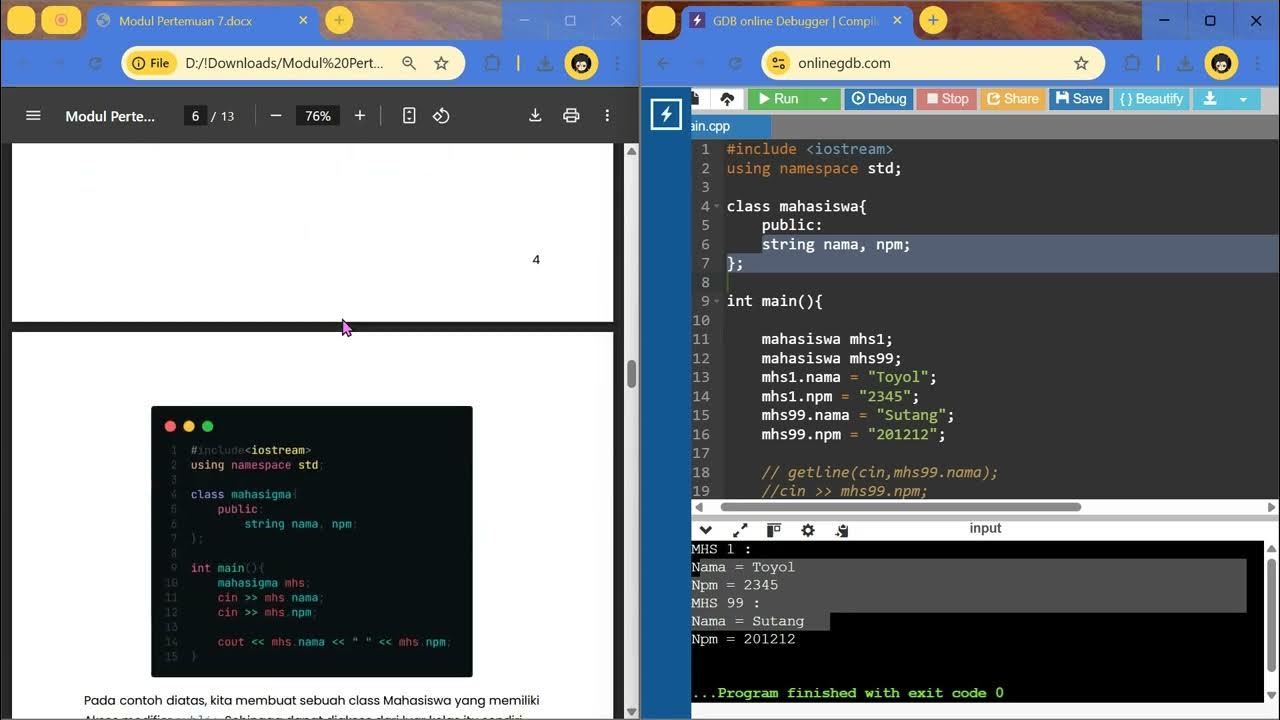5. Constructor
Summary
TLDRThis video explains the concept of constructors in object-oriented programming (OOP). A constructor is a special method used to initialize objects when they are created, with the same name as the class and no return value. The video highlights key differences between constructors and methods, such as the use of parameters and initialization. A practical code example is provided, demonstrating how constructors work to set object properties like brand and color. The video concludes by emphasizing the importance of constructors for object creation and property initialization in OOP.
Takeaways
- 😀 A constructor is a special method in object-oriented programming, executed when an object is first created.
- 😀 A constructor has the same name as the class it belongs to.
- 😀 Unlike regular methods, a constructor does not return a value.
- 😀 Constructors can accept parameters, which must be provided when creating an object.
- 😀 A constructor is used to initialize the properties of an object.
- 😀 The example given in the video demonstrates a constructor with two parameters, 'brand' and 'color'.
- 😀 When defining the constructor, parameters are used to set the values for the class properties (e.g., brand and color).
- 😀 In the video, the constructor is tested using the 'Toyota' brand and 'blue' color values.
- 😀 The constructor works by filling the 'brand' and 'color' properties with the values passed as arguments when creating the object.
- 😀 The video shows how to test if the constructor properly initializes the object by printing the values of 'brand' and 'color'.
- 😀 The final output demonstrates that the constructor correctly assigns values to the 'brand' and 'color' properties, displaying 'Toyota' and 'blue'.
Q & A
What is a constructor in programming?
-A constructor is a special method that is automatically executed when an object is first created. It is used to initialize the object's properties or perform any necessary setup tasks.
How is a constructor different from a method?
-A constructor has a few key differences from a method: its name must be the same as the class name, it does not return a value, and it is automatically called when an object is created. A method, on the other hand, can return a value and can be called explicitly.
What are the rules for naming a constructor?
-The constructor's name must match the name of the class in which it resides. This is a key distinction between a constructor and a regular method.
Can a constructor return a value?
-No, a constructor cannot return a value. Its primary purpose is to initialize the object, not to provide a return value like methods do.
What happens when you create an object with a constructor that accepts parameters?
-When creating an object with a constructor that accepts parameters, you need to provide values for those parameters. These values are then used to initialize the object's properties.
How do you define parameters in a constructor?
-Parameters in a constructor are defined within parentheses after the constructor's name. These parameters act as input values, which are used to set the initial state of the object's properties.
What is the purpose of the 'this' keyword in a constructor?
-The 'this' keyword refers to the current instance of the object. In a constructor, it is used to assign values to the object's properties from the constructor parameters.
Why is it necessary to pass values when creating an object using a constructor with parameters?
-It is necessary to pass values to ensure that the object's properties are properly initialized. The constructor's parameters define how the object will be set up when it is created.
What will happen if you don't provide the required arguments when calling a constructor with parameters?
-If the required arguments are not provided when calling a constructor, you will encounter an error, typically indicating that the constructor expects a certain number of arguments.
Can you have multiple constructors in a class?
-Yes, you can have multiple constructors in a class, which is known as constructor overloading. Each constructor can have a different number of parameters or different types of parameters to offer flexibility when creating objects.
Outlines

Esta sección está disponible solo para usuarios con suscripción. Por favor, mejora tu plan para acceder a esta parte.
Mejorar ahoraMindmap

Esta sección está disponible solo para usuarios con suscripción. Por favor, mejora tu plan para acceder a esta parte.
Mejorar ahoraKeywords

Esta sección está disponible solo para usuarios con suscripción. Por favor, mejora tu plan para acceder a esta parte.
Mejorar ahoraHighlights

Esta sección está disponible solo para usuarios con suscripción. Por favor, mejora tu plan para acceder a esta parte.
Mejorar ahoraTranscripts

Esta sección está disponible solo para usuarios con suscripción. Por favor, mejora tu plan para acceder a esta parte.
Mejorar ahoraVer Más Videos Relacionados

1. Pengenalan OOP - Dart OOP

Pertemuan 7 Pemrograman Terstruktur 2025

Object Oriented Programming Dasar pada C++ (Class, Object, Method, dan Constructor)

Como criar Classes e Objetos - Curso Python Orientado a Objetos [Passo a Passo]

Object-Oriented Programming Illustrated

Object-Oriented programming Course Intro
5.0 / 5 (0 votes)
